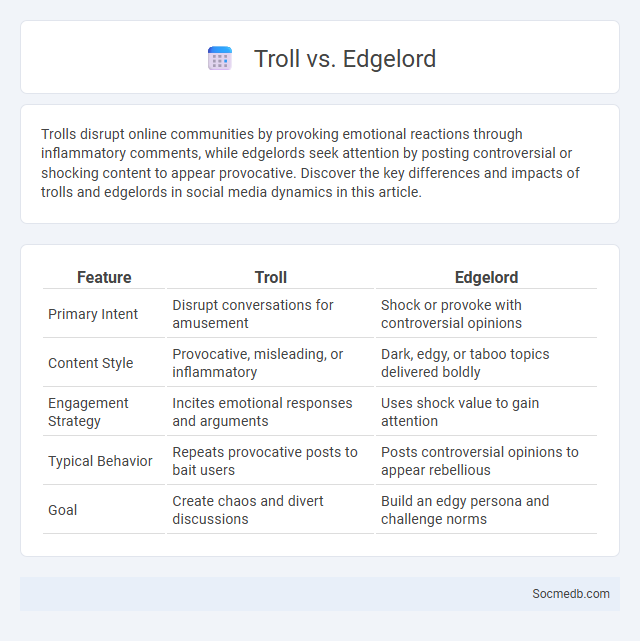
Photo illustration: Troll vs Edgelord
Trolls disrupt online communities by provoking emotional reactions through inflammatory comments, while edgelords seek attention by posting controversial or shocking content to appear provocative. Discover the key differences and impacts of trolls and edgelords in social media dynamics in this article.
Table of Comparison
| Feature | Troll | Edgelord |
|---|---|---|
| Primary Intent | Disrupt conversations for amusement | Shock or provoke with controversial opinions |
| Content Style | Provocative, misleading, or inflammatory | Dark, edgy, or taboo topics delivered boldly |
| Engagement Strategy | Incites emotional responses and arguments | Uses shock value to gain attention |
| Typical Behavior | Repeats provocative posts to bait users | Posts controversial opinions to appear rebellious |
| Goal | Create chaos and divert discussions | Build an edgy persona and challenge norms |
Understanding the Terms: Troll, Edgelord, and Their Origins
Understanding the terms troll and edgelord requires delving into internet culture where trolls deliberately provoke or disrupt conversations for reactions, originating from early online forums and chatrooms. Edgelords, a more recent term, describe individuals who post purposely controversial or offensive content to appear shocking or gain attention, reflecting a need for online identity and influence. Your awareness of these roles helps navigate social media interactions with greater insight and avoid potential conflicts.
Key Differences Between Trolls and Edgelords
Trolls on social media deliberately provoke and disrupt conversations by posting inflammatory or off-topic messages to elicit strong emotional reactions, often hiding behind anonymity. Edgelords, by contrast, aim to shock or offend with controversial, provocative opinions or humor, seeking attention and social currency rather than merely disruption. Understanding these distinctions helps platforms develop more effective moderation strategies tailored to the unique behaviors of each group.
Motivations Behind Trolling and Edgelording
Trolling and edgelording often stem from a desire for attention, social influence, or emotional release in online communities. These behaviors can be motivated by seeking validation, testing boundaries, or expressing controversial opinions to provoke reactions. Understanding your role in these interactions helps manage digital spaces and fosters more respectful communication.
Common Behaviors and Tactics Used
Social media users frequently engage in behaviors such as liking, sharing, and commenting to increase visibility and interaction on their posts. Tactics like leveraging trending hashtags, posting during peak hours, and creating engaging content are employed to optimize reach and influence audience engagement. Understanding these common behaviors and tactics helps you effectively navigate and grow your presence on social media platforms.
The Impact of Trolls vs. Edgelords Online
Trolls disrupt online conversations by spreading misinformation and provoking emotional reactions, undermining genuine social interaction on social media platforms. Edgelords often push controversial content to gain attention and challenge societal norms, which can polarize communities and escalate conflicts. Understanding how trolls and edgelords influence your digital experience helps in managing online interactions and maintaining a positive social media environment.
Examples of Notorious Trolls and Edgelords
Notorious trolls like Andrew Auernheimer and Christopher Cantwell have gained infamy for deploying inflammatory rhetoric and disruptive content across platforms such as Twitter and YouTube, fostering online chaos and division. Edgelords, including figures like Milo Yiannopoulos and Destiny, intentionally push controversial opinions and provocative memes to challenge social norms and provoke strong reactions. Understanding these behaviors can help you navigate social media more wisely and maintain a positive digital environment.
Community Reactions and Coping Strategies
Community reactions on social media often include diverse perspectives that reflect collective emotions and social dynamics, influencing public opinion and shaping digital discourse. Your engagement with these platforms benefits from adopting effective coping strategies such as setting boundaries, curating content, and practicing digital detox to maintain mental well-being amidst constant information flow. Understanding these interaction patterns helps mitigate stress and fosters resilient online communities.
Ethical Implications of Trolling and Edgelording
Trolling and edgelording on social media platforms raise significant ethical concerns, including the promotion of harassment, misinformation, and toxic discourse that can harm individuals and communities. These behaviors often exploit anonymity to evade accountability, undermining constructive dialogue and contributing to mental health challenges among targeted users. Addressing the ethical implications necessitates robust moderation policies, education on digital civility, and platform designs that discourage harmful interactions while fostering respectful engagement.
How to Identify Trolls and Edgelords
Recognizing trolls and edgelords on social media involves observing their patterns of behavior, such as posting inflammatory or provocative comments that aim to disrupt conversations or evoke strong emotional reactions. Trolls often use sarcasm, insults, or exaggerated opinions to bait users, while edgelords push boundaries by sharing controversial or shocking content to gain attention. By paying attention to these tactics and maintaining critical awareness, you can protect your online space and avoid engaging with disruptive individuals.
Prevention and Response: Managing Toxic Online Behavior
Effective management of toxic online behavior requires implementing proactive prevention strategies such as AI-powered content filtering and user education programs promoting digital civility. Rapid response mechanisms, including real-time monitoring and swift enforcement of community guidelines, help mitigate harm and support victims of harassment. Collaboration between social media platforms, law enforcement, and mental health organizations enhances the effectiveness of interventions and fosters safer online environments.
 socmedb.com
socmedb.com